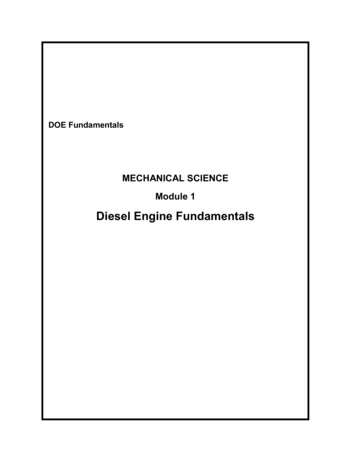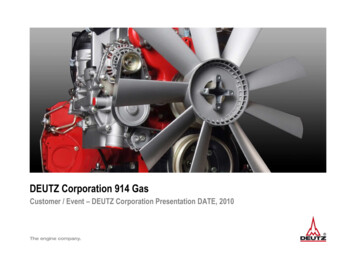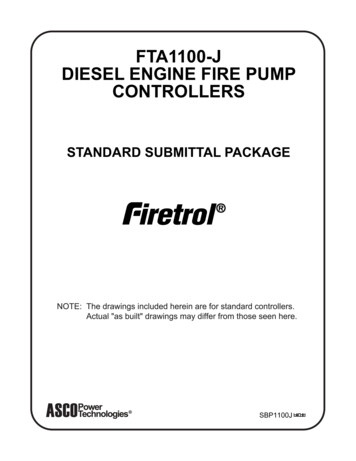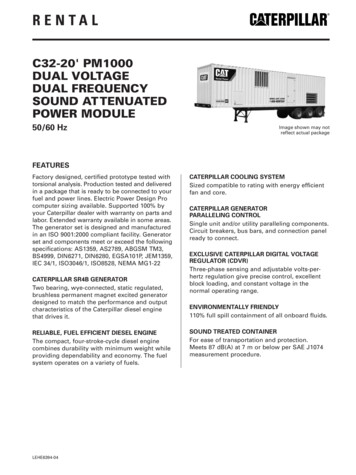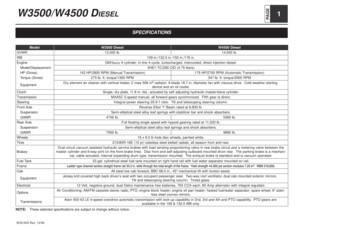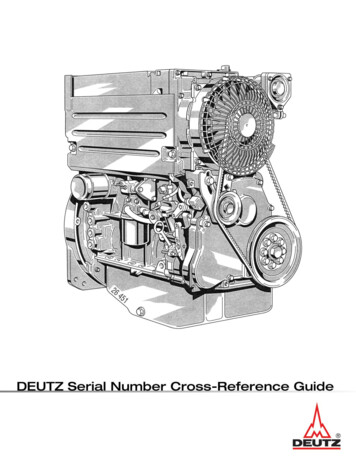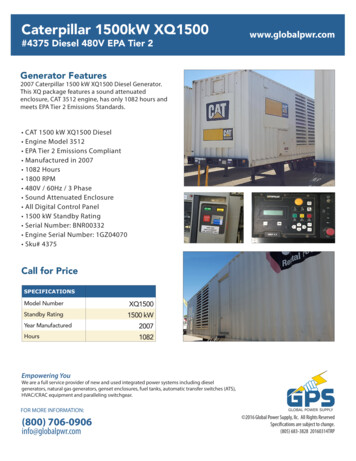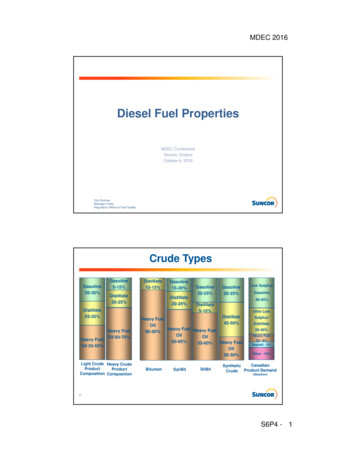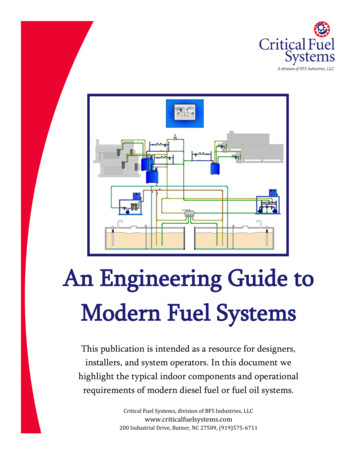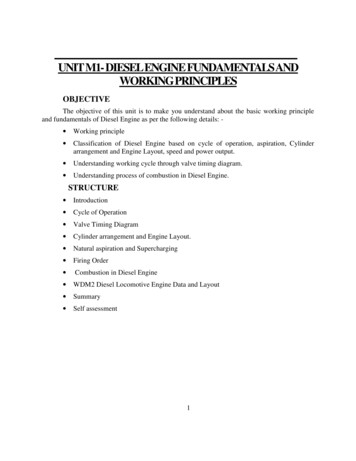
Transcription
UNIT M1- DIESEL ENGINE FUNDAMENTALS ANDWORKING PRINCIPLESOBJECTIVEThe objective of this unit is to make you understand about the basic working principleand fundamentals of Diesel Engine as per the following details: Working principle Classification of Diesel Engine based on cycle of operation, aspiration, Cylinderarrangement and Engine Layout, speed and power output. Understanding working cycle through valve timing diagram. Understanding process of combustion in Diesel Engine.STRUCTURE Introduction Cycle of Operation Valve Timing Diagram Cylinder arrangement and Engine Layout. Natural aspiration and Supercharging Firing Order Combustion in Diesel Engine WDM2 Diesel Locomotive Engine Data and Layout Summary Self assessment1
INTRODUCTIONAs commonly known, there are two types of engines i.e. External Combustion Engineand Internal Combustion Engine. The examples of External Combustion Engine are Coal or oilfired steam engines and those of Internal Combustion engine are Petrol, Diesel and Gas engine.In External Combustion engine, coal or liquid fuel is burnt outside the cylinder, but inInternal Combustion engine the fuel burns inside the cylinder.The Internal Combustion engines are again divided into two groups i.e.(i) Spark Ignitionengines and (ii) Compression Ignition engine, Example of spark ignition engine is petrol and gasengine where-as example of compression ignition engine is diesel engine.The basic purpose of an IC engine is to develop power by burning fuel. Therefore, goodperformance of an Engine is dependent on how quickly and completely the fuel can be burnt.This burning of hydrocarbons is called combustion, which is a chemical process (oxidation),accompanied by emission of light and heat.The petrol or gas engines are called spark ignition engines, as electric spark is requiredfor ignition of fuel air mixture, which is injected in the mixture form in the combustion chamber.The process of combustion in the compression ignition engine differs widely from that ofspark ignition engine. In case of diesel engine only fuel in liquid state is injected at very a highpressure, into highly heated and compressed air in the combustion chamber, the heat of thecompressed air starts the combustion process and no agency like electric spark is required.The name 'Compression Ignition Engine’ has been derived from the fact that the airdrawn in the suction stroke is compressed to such a degree in compression stroke, that the heatgenerated due to compression goes much above the self ignition or auto-ignition temperature ofthe liquid fuel.The abbreviation IC Engine' (Internal Combustion Engine) and C.I.Engines(Compression Ignition Engine) sometimes causes confusion. Though both petrol and dieselengines are I.C.Engines', only diesel engines work on Compression Ignition principle andshould be termed as C.I.Engines'. In other words while all C.I.Engines' are I.C.Engines' but all I.C.Engines' are not C.I.Engines'.Compression RatioThe compression ratio of I.C.Engines' is the ratio between total volume i.e. (clearancevolume swept volume.) and clearance volumeIn other words this ratio is indicative of the degree of compression of the trapped air.Higher the compression ratio, higher will be the compression pressure and consequently higherthe temperature.It is for this reason that compression ratio of spark ignition engine is lesser (round about8:1) whereas the compression ratio of compression ignition engine is 12:1 & above.CYCLE OF OPERATIONIn any Compression Ignition engine following pre-requisites must be fulfilled.2
(a) Suction or InductionThe suction or induction of fresh cool air must take place for the purpose of providingoxygen for combustion of fuel as also for the scavenging of burnt gases and taking away heatfrom the combustion chamber components.(b) Compression:Once the air is drawn in, the air inlet passage is closed. The trapped air is compressed dueto upward movement of pistons. Once the air is highly compressed, it attains high temperature.At this stage fuel is injected just before the T.D.C. for combustion to start.(c) Firing or Power:Very shortly after the fuel injection, the firing takes place and peak pressure is achievedjust after TDC, the expansion of gas provides the force or power which drives the piston back,thus rotating the crank shaft.(d) Exhaust:After the fuel is burnt out, the burnt gas has to find passage to atmosphere so that spacecan be made for accommodating fresh air for the next cycle of operation.The aforesaid requirements are fulfilled in either four strokes of piston or in 2 strokes. Incase of the former the engine is called a four stroke cycle engine and in case of the latter theengine is called two stroke cycle i.e. either two revolutions or one revolution of the crankshaftcover all the events of the cycle.FOUR STROKE/ TWO STROKE CYCLEWhile in four stroke cycle engines, suction, compression, fuel injection, exhaust andscavenging, are completed in four strokes of the piston or two revolutions of the crank, in twostroke engines all these are completed in two strokes of the piston or one revolution of thecrankshaft.(Sk.1.1. & Sk.1.2.)There are various designs of 2 stroke cycle engines but one thing common in all, is thatcompressed air is essential for the purpose of scavenging right from the lowest power outputwhereas in case of 4 stroke cycle engine at lower power range it works as naturally aspiratedengine.To describe this process in greater detail, we can take the example of the WDG4locomotive, in which all the exhaust valves are in the cylinder head at the top and the inlet portsare round the cylinder liner.VALVE TIMING DIAGRAMValve Timing Diagram of 2 stroke (WDG4/ GM Engine) and 4 Stroke (WDM2 Engine)is being dealt separately for better understanding.3
Sk: 1.14
Sk: 1.25
Sk: 1.36
VALVE TIMING- TWO STROKE CYCLE (sk: 1.3)Just before the TDC, the fuel injection starts and the power stroke begins just after theTDC. After the piston has moved down partly, and the crank is at a position of 109O from theTDC, or 71O from the BDC, the exhaust valves open allowing the exhaust to escape. With theescape of the part of exhaust gas, the pressure in the combustion chamber falls. By this time thepiston has gone further down, and when the crank comes to 43.5O before TDC, the pistonuncovers inlet port on the sides, and scavenging air finds access into the cylinders and tries topush out the exhaust gases. This process continues upto 43.5O after the BDC. Thus for a periodof 87O , both exhaust valves and the inlet ports remain open. After 43.5O after the BDC, the inletports close, but the exhaust ports still remain open. At this time, the lower port of the combustionchamber is full of fresh air, and the upper port is filled with a mixture of burnt gas and air. Withfurther movement of piston in the upward stroke, the piston has moved further, bringing thecrank to about 67O after the BDC, and the exhaust valves close. The trapped gas contains mostlypure air, and compression takes place. While compression is taking place at about 15.8O beforethe TDC, the fuel is injected at a high pressure against hot compressed air. The firing starts withpeak pressure being reached just after the TDC. From the above, it is seen that in the first ordownward stroke, this type of engine, following takes placeAcombustion of fuel, giving power, forcing the piston to go down.Bexhaust of the burnt gas starts at 109O after TDC or 71O before BDC.Cscavenging and inlet of fresh air starts at 43.5O before BDC.Therefore, only a part of the downward stroke is power stroke, and the rest is taken up bythe exhaust and scavenging. Similarly, in the upward stroke, the following takes place.Ainlet of fresh airBdischarge of balance of burnt gasCcompression of trapped airDfuel injection into the compressed hot air.7
VALVE TIMING DIAGRAM - 4 STROKE CYCLE:Sk: 1.48
As already stated this type of engine needs four strokes of piston or two revolutions of thecrankshaft to cover all the events of the cycle Though, superficially it appears that each of thestroke is distinctly for one major event but in actual practice it is not quite so. These events sometimes over lap between two strokes for better performance.At the later part of the exhaust stroke when the piston is still moving upwards withexhaust valve already open, the inlet valve opens at 63O48'/80.1o before the TDC. Thesupercharged air at about 1.5 kg/cm2, above the atmospheric pressure reaches through the inletvalves and pushes out the burnt gas. This process continues upto 60o /57.77o after TDC when theexhaust valve closes.SUCTION:When the exhaust valve closed and piston continuing to move downwards, more andmore fresh cool air is sucked in through the inlet valves. But the suction does not end just at theBDC and continues up to 29o 40'/35.4o after BDC when inlet valve closes. The extra movementof the crank by this amount provides some more time for more air to find access in cylinder dueto "wire drawing" or interalia' effect. This extra time was not necessary if the size of the valvewas as large as the size of the piston. But this is not practicable due to obvious reasons. In orderto get more air through the restricted air inlet passage more time is required. Thus the firstdownward stroke is partly for scavenging and the rest for suction.COMPRESSION:Subsequent to the air inlet valve closing at 29o 40'/ 35.4o after BDC the air drawn in thecylinder gets trapped as the exhaust valve also is closed from before. Now with the pistonmoving upwards in second stroke, compression takes place right up to the TDC but just 18 1/4obefore the TDC when the air is well compressed and heated up, combustion of the fuelcompressed starts and peak pressure is achieved a little after TDC.Thus the second stroke (upward stroke) is partly suction and the rest compression in thelater part of which the fuel injection also starts.POWER:In the 3rd (downward) stroke the high pressure developed in the combustion chamberforces the piston down and is called power stroke. But, a little before the end of this stroke(41O28'/57.67o before BDC) the exhaust valve opens and the burnt gases under some pressurefind outlet through the exhaust valve and the residual pressure and energy which was of notmuch consequence in developing power in the cylinder helps in driving turbo-charger and extratime with exhaust valves open avoids back pressure in the exhaust stroke.Thus, the third (Downward) stroke is mainly a power stroke and a part in the later and isused for exhaust of burnt gases.EXHAUST:After the piston passes the BDC the 4th (upward) stroke starts and physically pushes theburnt gas out. But at a point 63O48' before the TDC the inlet valves open with exhaust valvealready in open condition. At this stage the pressure of exhaust gas has come down considerablyand the pressurized inlet air scavenges the burnt gas. This continues till 60o/ 57.77o after BDC9
when the exhaust valve closes, thus completing the full cycle. Thus the 4th (upward) stroke ismainly exhaust stroke, but the later part of it is used for scavenging when both inlet and exhaustvalves are in open condition. Scavenging has a significant effect on the efficiency of engine. Inconventional engine it was 123o48′ and in fuel efficient it has increased to 137.87o.From the above, it will be clear that the four strokes of this type of engine covers all therequisite events of Compression Ignition engines.The valve and fuel injection timing of each engine vary to give optimum outputdepending on the valve size, cylinder diameter compression ratio, degree of supercharging etc.Thus, it can be seen that in a four-stroke cycle, every alternate downward stroke is apower stroke, whereas in two-stroke cycle, every downward stroke is a power stroke. This factsometimes leads to the wrong impression that, for the same size and number of cylinders, a twostroke cycle engine is capable of developing double the power of the four-stroke cycle engine ofsame description. This is however not true. The reasons for this are1.Only a small part of the downward stroke can be utilized as a powerstroke.2.Greater amount of burnt gas remains in the cylinder mixed with newcharged air. The above reasons result in much lesser fuel can be injected per powerstroke. Naturally the impression that two stroke cycle engine of same rpm and cylindersize and stroke can develop double the horsepower is not correct. In fact, experienceshows that SFC in a two-stroke cycle engine is slightly higher than a four-stroke cycleengine.CYLINDER ARRANGEMENTS AND ENGINE LAYOUTBoth 2-stroke and 4-stroke cycle can be with many arrangements of cylinders. For railtraction use, in our country, only inline vertical engines, V-engines, and inline horizontal enginesare used. Vertical inline engines are used for low hp shunters. V-engines are used for higher hp.NATURAL ASPIRATION AND SUPERCHARGINGNaturally aspirated engines are those which draw air in the cylinder at a pressure slightlylower than the atmospheric pressure, when partial vacuum is created in the cylinder by outwardmotion of the piston in the suction stroke, due to inertia of air and unavoidable restriction toflow, resulting in cylinder air pressure being slightly below atmospheric pressure. The demandfor more and more power output of the engine, charging of the cylinder with pressurised air hadto be resorted to, so that more fuel can be burnt and more power can be produced. Pressurecharging of inlet air can be done by Aengine crankshaft driven centrifugal blowerBroots blowerCexhaust gas driven turbocharger.When specifically designed for supercharging, power gains can range from 50% to 100%.10
ENGINE SIZES AND SPEEDDiesel engines are now put in various types of use depending upon usage; the engines aremade in vast range of sizes and speeds. While generally engines are classified in three groups,depending upon the speed and size, there is now well defined demarcation and there can beconsiderable overlap between adjacent groups. Normally low speed engines are not used fortraction purposes, as they are too heavy and bulky, and therefore, they are used mostly formarine work or for stationary duties. The medium As well as high-speed engines are used for railtraction purposes.FIRING ORDERIn case of four-stroke cycle engine, there is only one power stroke in the four strokes ofpistons or every two revolutions of the crankshaft. It is therefore necessary to have a flywheel, togive a 'carry over' for the three "waste" strokes and to ensure a smoother power output. Toincrease the power output and to make it smoother, multi-cylinder engines are used in which, thefiring strokes on different cylinders are suitably spaced in relation to the crank angles so thatduring the revolutions of the crankshaft, firing of the cylinders takes place one by one at regularintervals.For even firing in a four-stroke engine, one cylinder must be allowed to fire during eachof the four strokes and, therefore the crankshaft arranged at 720O/4 180O intervals, and for asixteen-cylinder engine, it is 720O/16 45O.It follows from the above that as the number of cylinders increases, the power outputbecomes smoother. The firing order is used to prevent damage arising from vibrations setup inthe crankshaft, the sequence of firing is so arranged that the vibrations tend to cancel out as far aspossible. It may, however, be mentioned that in large engines, running at high speeds, the firingorder may not by itself, prevent the buildup of vibrations, and, therefore vibration dampers aremounted on the crankshaft. For our railway standard engines, the following firing order has beenprescribedWDM2 WDS6/YDM4 LOCOMOTIVES1-4-2-6-3-511
COMBUSTION IN DIESEL ENGINEThe basic purpose of IC Engine is to develop power by burning fuel. Therefore, goodperformance of an IC Engine is dependent on how quickly and completely the fuel can be burnt.This burning of hydrocarbons is called combustion, which is a chemical process (oxidation),accompanied by emission of light and heat.The process of combustion in the compression ignition engine differs widely from that ofspark ignition engine. In case of diesel engine only fuel in liquid state is injected at very a highpressure, into highly heated and compressed air in the combustion chamber, the heat of thecompressed air starts the combustion process and no agency like electric spark is required.Process of combustionIf we allow diesel fuel to remain inside a room oxidation will take place, but very slowly.As the temperature of air is raised the process speeds up, ultimately we reach a critical stagewhere the heat is generated, by oxidation, at a higher rate than it is dissipated. This results inautomatic rise in temperature, quicker oxidation and consequent further evolution of heat. Thiscritical temperature is called "Auto-ignition" temperature. This critical temperature of fuel isdependent on factors like type of fuel, pressure etc.Now when fuel oil at a high pressure is sprayed into the combustion chamber filled withpressurized air, the droplets behave in following manner, of-course in matter of milliseconds.The extreme outer surface of the droplet will immediately start to evaporate, thus surroundingthe core with a thin film of vapour. To accomplish this, however, heat must be withdrawn fromthe air in immediate contact with the droplet in order to overcome the latent heat of evaporationof the liquid. Thus the immediate effect is to reduce the temperature of a thin layer of airsurrounding the droplet and some time must elapse before reaching main bulk of air at itsvicinity. As soon as this vapour and the air comes in actual contact with it, reach a certaintemperature, ignition will take place, although the core is still liquid and relatively cold. Onceignition has been started and a flame established, the heat required for further evaporation wouldbe supplied from that released by combustion. We have, then a core of liquid surrounded by alayer of vapour which is burning as fast as it can find fresh oxygen to keep the process going,and this condition continues unchanged until the whole is burnt.12
Sk: 1.5.313
1. Disintegration of stream of injected fuel.2. Mixing of liquid fuel with air3. Vaporisation of fuel4. Mixing of fuel vapour with air fuel vapour with air.5.Preflame oxidation of fuelSk: 1.5.46. Local ignition7. Inflamation8. Oxidation of fuel air mixture/ 8A. Thermal decomposition of fuel9. Mixing of products of partial oxidation or of thermal decomposition with air.10. Temp and Oxygen concentration favorable for complete combustion.11. Products of complete combustion12. Temp and Oxygen concentration not favorable for complete combustion (chilling,over lean and over rich mixture.)13. Products of incomplete combustionPhases of combustionThough the process of combustion of fuel particles is completed in matter ofmilliseconds, scientists have analysed the process and have come to conclusion that the processcovers the following distinct phases. (See Sk.1.5.1 and 1. 5.2)1 Delay period (2) Uncontrolled combustion (3) Controlled combustion & (4) Burning in14
expansion stroke.1. Delay periodHowever small the period may be, for reasons mentioned in preceding paragraphs, sometime will elapse between actual injection of fuel in combustion chamber to the inflammationstage when pressure will shoot up. The delay period is affected by factors like 1. Size of fuel droplet,2. Air charge temperature at the time of injection,3. Pressure in combustion chamber,4. Turbulence of air in combustion chamber,5. Cetane Number of fuel used,6. Fuel injection advance.It is essential to have suitable delay time to facilitate fuel droplets reaching the furtherends of combustion chamber and have better fuel air mixture. Less or no delay period will resultin incomplete combustion and localised burning near the nozzle tip. Similarly longer delay willlead to Diesel knock and combustion in expansion stage. Hence delay period should becontrolled within optimum range.2. Uncontrolled combustionThis phase is often termed as flame spread. It is the period of rapid combustion of fuelalready accumulated in the delay period and partly also those injected during the controlledcombustion period. Since the charge has already accumulated and exploded giving sudden rise ofpressure, it is called uncontrolled combustion. This phase should start just before the pistonreaches top dead centre and should be completed little after top dead centre.The factors which affect this phase are(a) Duration of Phase-I(b) The items which control the Phase-I.In other words, longer the delay period, more will be the accumulated fuel charge andhigher will be the pressure rise.3. Controlled combustionAfter the steep rise in pressure comes to an end, the rate of increase of pressure comesdown and the curve stoops down comparatively. This controlled combustion phase is from theend of uncontrolled combustion phase to a little after the end of fuel injection. The reasons forthis portion of curve being less steep are that in this phase, unlike the previous phase the fuelwhich is coming in is burning and that the piston has started residing resulting in reduction in therate of increase of pressure rise. The aspects having effect on this phase are:a) Duration of phase-I and,b) Fuel injection timing,c) Factors which control phase-I and II4. Combustion in expansion stroke:This phase is generally not taken into account, as in ideal conditions this should not exist.But never the less it exists and in this period unburnt fuel gets burnt as it finds oxygen. But thisdoes not contribute to engine output and hence the lesser it is, the better.Though theoretically the phases of combustion have been shown distinct from each otheras shown in Sk.1.5.1, the actual indicator diagram shows the combustion curve as shown in15
Sk.1.5.2.Sk.1.5.3. shows that with the increase of pressure the air temperature increases and theauto ignition temperature level goes down slightly.The flowchart of combustion as shown in Sk.1.5.4 indicates that delay period is subdivided in two parts i.e. physical delay and chemical delay. It can also be seen that due totemperature going higher than what is conducive to proper combustion, and for some otherreasons, fuel vapours crack up into elements, a portion of which again take part in the process ofcombustion.It will be appreciated that the whole process is completed in about 0.005 seconds and thishighly limited time has been a bar on further detailed analysis of this stage.QUALITY OF AIR REQUIRED AND TURBULANCE: Since power of an engine is largely dependent on the quality of air it inhales andcompresses per cycle, it is necessary to have an idea about the quantity of air required for propercombustion. It is known that atmospheric air consists of 3.32 parts of nitrogen by weight ofoxygen to produce 4.32 parts by weight of air. In other words in order to get 1 kg of oxygen wehave to get 4.32 kg of air.With the; help of simple chemical formula we can find out the quantity by wt. of airrequired to burn combustible substances. The diesel fuel is nothing but a combination of variousgroups of hydrocarbons. Though there are 29 and odd varieties of hydrocarbons presence of afew varieties is predominate in particular, types of fuel oil. It has been found that for burning l kgof HSD oil a theoretical quantity of approximately 18-kg of air is required. But the entirequantity of air pressed into the combustion chamber does not come into play in the process ofcombustion and as such an excess quantity i.e. 28 kg approximately is given for every kg of fuelburnt.But providing excess amount of air alone will not suffice for having completecombustion. If the air within the cylinder was motion-less it would be evident that only one smallportion of the fuel would find enough oxygen. Since it is impossible to distribute fuel dropletsuniformly to fill up the entire combustion chamber space. Considerable relative motion betweenair and the fuel is necessary to ensure not only continuous supply of fresh air to each burningparticle but also to sweep away the products of combustion which may otherwise have atendency to suffocate combustion. Therefore, the rate of burning depends to a great extent on therate at which the products of combustion can be removed from the outer surface of the particlesso that the fuel vapour comes in contact with fresh hot air and thereby get heat and oxygen. Inother words it depends upon the rate at which burning droplets are moving across the air and alsoair across the droplets.Combustion chamber design:The main aim of combustion chamber design is to effect rapid and complete combustionof fuel by creating high relative velocity or turbulence thus resulting in thorough mixing of airand fuel.The above effect is achieved by following methods: (a) Giving a particular shape to the inlet air passage so that the airflow is so directed thatit has maximum effect in moving across the fuel particles. This is called in-take induced "Swirl".(b) By giving such valve angle that would have max. Possible airflow which would cut16
across fuel particles in the best manner possible. Use of masked valve in combination withdirectional part is also resorted to for this purpose.(c) The piston crown is given particular shape to aid the swirl of air. This is some times calledpiston induced "Squish".(d) Diesel designers working in close co-operation with fuel injection engineers have producedmany successful conformations for combustion chambers. The type used is also dependentupon engine size, speed, type and application. Combustion chamber types being producedtoday may be classified as :1. Pre-combustion chamber or quiescent pre-combustion chamber.2. Air cell or energy cell3. Turbulent chamber of turbulent pre-combustion chamber4. Open combustion chamber with direct injectionBut with the advent of highly super-charged engines it has been found that excepting forproviding directional port and slight concave shape of cylinder head surface and piston crown inan open combustion chamber no other complication is necessary.All the standard diesel locos of Indian Railways are provided with this type ofcombustion chamber.WDM 2 DIESEL LOCOMOTIVE ENGINE DATAIn WDM2 class locomotives, ALCO design 251B model 16-cylinder exhaust gas turbosupercharged closed circuit water cooled, compression ignition medium speed four-stroke dieselengine is used. The engine's general characteristic and ratings are given belowCYCLE4 STROKE CYCLEASPIRATIONTURBOSUPERCHARGEDCOOLINGBORE9 INCHES (228 mm)STROKE10.5 inches (267 mm)COMPRESSION RATIOCONCAVE CROWN STYLE12.5:1FLAT CROWN STYLE11.5:1HORSEPOWER (GROSS)2600 BHPENGINE SPEED1000 RPM (FULL LOAD)400 RPM (IDLEPISTON SPEED (MEAN)9.89 m/secBMEP13.57 kg/cm2SWEPT VOLUME PER CYLINDER10.5 ltrs.WEIGHT (DRY ENGINE)19026 kg17WITHCHARGEAIR
ENGINE EQUIPMENT LAYOUT-WDM2 EXTERNAL VIEW (Fig: Sk-1.6)1.Base engine/ crankcase /oil sump2.Sump3.Oil level depth gauge.4.Crankcase inspection door5.Lube oil pump6.Lubricating oil main header flange7.Crank shaft8.Connecting rod9.Lubricating oil pump with relief valve10.Engine block11.Main bearing cap12.Main bearing nut13.Fuel Pump lifter14.FP support15.Camshaft16.Lube oil pipe17.FP cover18.Fuel pump19.Water raiser pipe20.Cyl.head21.Exhaust manifold22.V-channel23.Rocker arm24.Inlet valve25.Fast coupling expresser drive26.Valve lever casing27.Adjusting screw28.HP tube29.Control shaft30.Push rod31.Push rod lifter32.Cyl.head stud33.Water header34.Exhaust manifold35.Exhaust manifold arm36.Inlet elbow37.Liner38.Piston39.Piston pin40.FIP support41Free end foundation bolt42S-pipe44Water riser18
Sk: 1.619
SUMMARYDiesel Engine is an Internal Combustion, Compression Ignition Engine. Operation Cycle of theDiesel Engine consist of the functions like Suction, Compression, Firing, Expansion andExhaust. Depending on the number of strokes required to complete one working cycle they aredivided into two groups – 2 Stroke & 4 Stroke cycle Engine. Valve Timing Diagram of 4 Strokeand 2 Stroke Engine indicates the correct opening and closing period of Valves and FuelInjection timing, hence, it correctly explains the duration of different functions of the Engine.Diesel Engines are further classified into Inline or V-shaped Engine, Naturally Aspirated orSupercharged Engine, depending upon the cylinder arrangement on the block and the airinduction system. Supercharging means charging of high-pressure intake air into the cylinder toimprove the efficiency and power output of the Diesel Engine. Supercharging can be done byany of the methods, through (1) engine crankshaft driven centrifugal blower/ roots blower (2)exhaust gas driven turbocharger. Firing Order determines the sequence of firing at differentcylinders of a multi cylinder Engine. Correct sequencing of Firing Order reduces the vibration ofa multi cylinder engine upto a large extent. Combustion in Diesel Engine explains the process ofcombustion . Different phases of combustion are- Delay Period, Uncontrolled Combustion,Controlled Combustion and Burning in expansion stroke. These phases determine the shape ofthe diesel cycle of the engine. Quality of air with turbulance is a vital factor for effectivecombustion. Turbulance is created by suitably designing the combustion chamber. A typicalWDM2 Diesel Locomotive Engine Data is being included for better understanding.SELF ASSESSMENT1. What do you understand by a Two stroke and a Four stroke cycle engine?2. What do you learn from the Valve Timing Diagram?3. What is the difference between a natural aspirated and a supercharged engine? Whatare the various methods of supercharging?4. What is the importance of firing order of a multi-cylinder engine? Mention the firingorder of WDM2 locomotive engine.5. What are the phases of combustio
7 VALVE TIMING- TWO STROKE CYCLE (sk: 1.3) Just before the TDC, the fuel injection starts and the power stroke begins just after the TDC. After the piston has moved down partly, and the crank is at a position of 109 O from the TDC, or 71 O from the BDC, the exh
